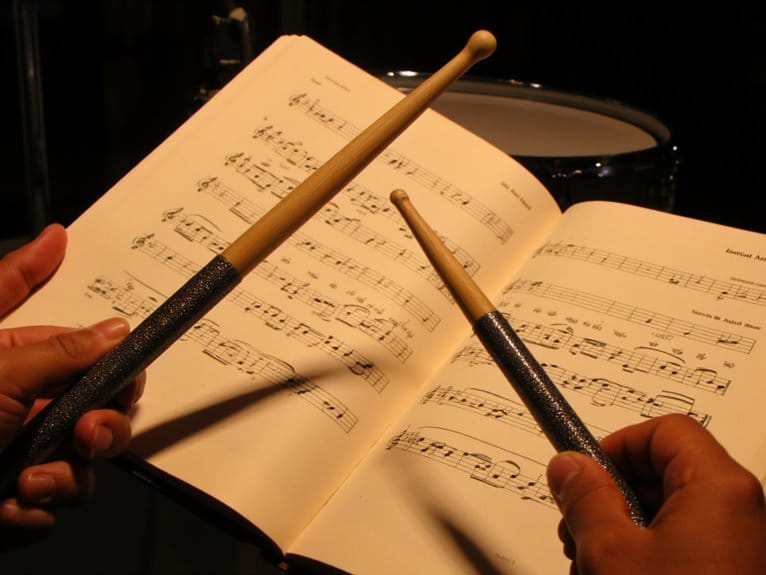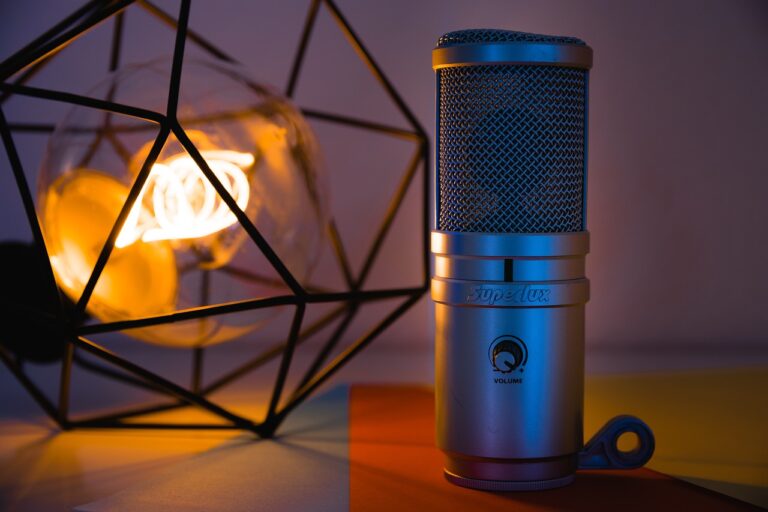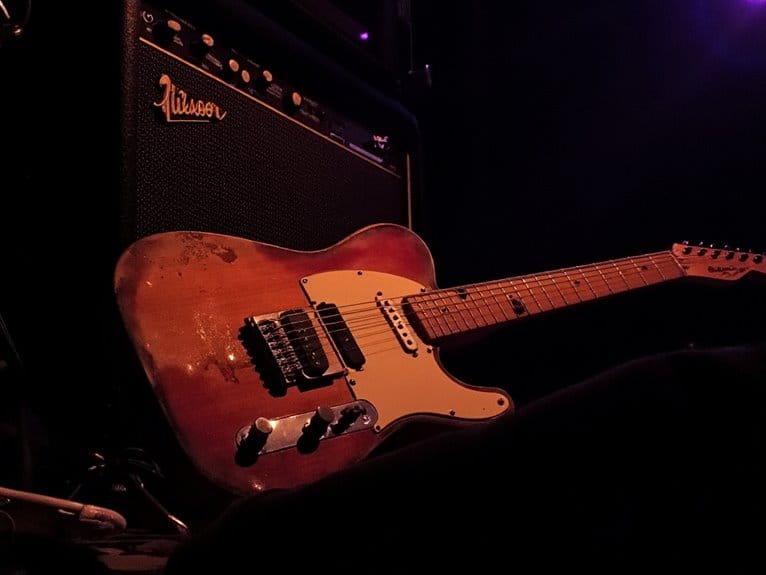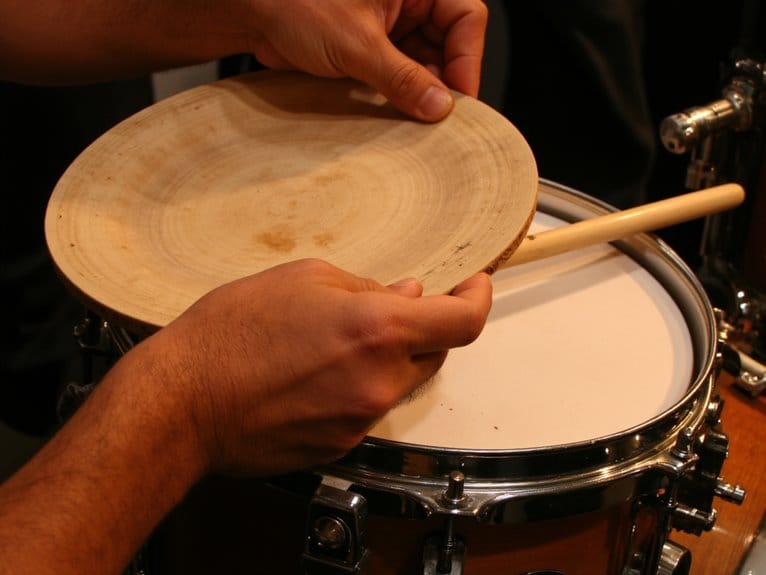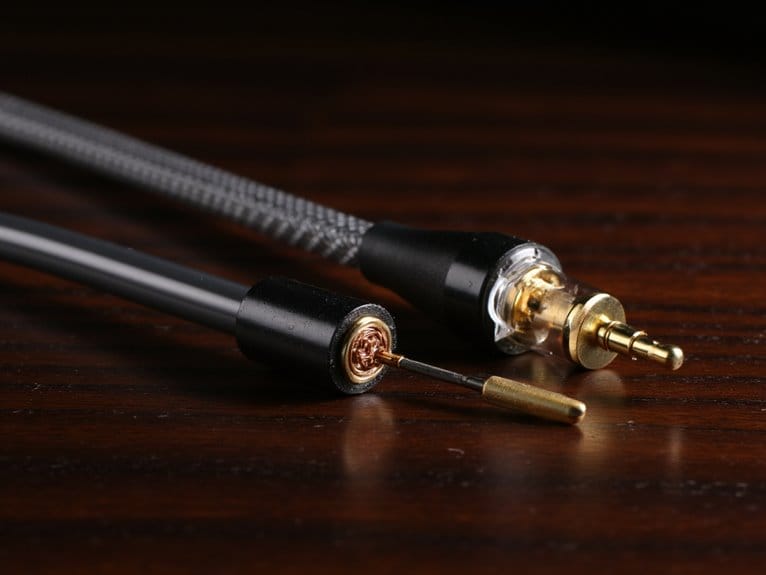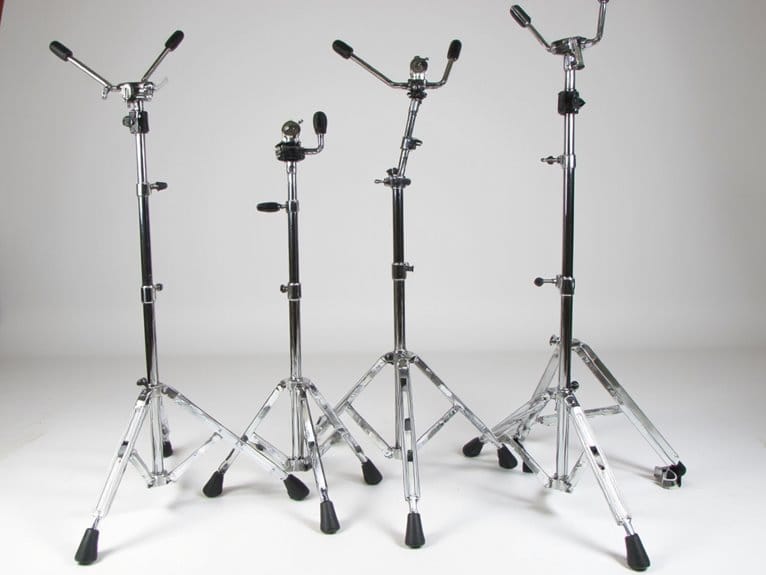Reading Drum Music and Notation Basics
You’ll read drum notation by understanding that the five-line staff maps directly to your physical kit, with bass drum positioned in the bottom space, snare on the second space, and cymbals marked with “x” noteheads above the staff. Quarter notes provide your one-beat reference, while eighth and sixteenth notes create subdivisions, and stems with flags indicate rhythmic groupings that progress left to right through measures separated by bar lines. Master these fundamentals and you’ll reveal advanced techniques that transform your musical expression.
We are supported by our audience. When you purchase through links on our site, we may earn an affiliate commission, at no extra cost for you. Learn more.
Notable Insights
- Drum notation uses a five-line staff where solid noteheads represent drums and “x” noteheads indicate cymbals.
- Bass drum sits in the bottom space, snare drum occupies the second/third space, with cymbals above the staff.
- Note values determine timing: whole notes equal four beats, quarter notes one beat, eighth notes half beats.
- Special symbols include accent marks for louder hits, ghost notes as smaller noteheads, and slashes for rolls.
- Reading progresses left to right with vertical bar lines separating measures, requiring practice for coordination and timing.
Understanding the Staff and Basic Drum Notation Symbols
When I first started learning drum notation, I’ll admit the staff looked more like a musical prison than a helpful guide, but understanding its structure is actually straightforward once you grasp the fundamentals.
You’ll work with five horizontal lines and four spaces, where each position represents a specific drum or cymbal in your kit. Staff interpretation becomes intuitive once you realize that solid noteheads indicate drum hits while “x” shaped noteheads represent cymbals.
The stems attached to these noteheads define your rhythmic grouping, telling you whether you’re playing quarter notes, eighth notes, or sixteenth notes. Developing stick definition and response through proper notation reading determines your versatility in performances across different musical styles.
Reading progresses left to right, just like text, with measures providing structured containers for your beats and rhythmic patterns. These vertical bar lines separate each measure and help organize the music into manageable sections for counting and rhythm development. Familiarizing yourself with these notation symbols enhances recognition speed, which directly improves your limb coordination and timing when playing.
Many drummers find that using practice pads helps reinforce proper notation reading while maintaining realistic rebound and response during quiet practice sessions. When you’re ready to apply your notation skills in recording situations, understanding dynamic microphones and their placement becomes crucial for capturing the authentic sound of each drum voice you’ve learned to read on the staff.
Drum Kit Components and Their Staff Positions
The geography of drum notation transforms your five-line staff into a detailed map of your drum kit, where each component claims its own specific territory based on pitch and function.
Your bass drum placement anchors everything in the bottom space, reflecting its foundational role with stems pointing downward since you’ll play it with your foot pedal. The distinctive snare drum sound gets prime real estate in the second or third space from the top, using standard round noteheads with upward stems.
Tom tom pitches cascade logically across the staff, with high toms claiming upper positions and floor toms settling into middle territory. Meanwhile, cymbal notation distinguishes itself with x-shaped noteheads positioned above the staff, creating clear visual separation from your drum components. Hi-hats operated with your foot pedal are notated below the bottom line, maintaining the neutral clef system that organizes percussion instruments by function rather than traditional pitch relationships.
Note Values, Rhythmic Symbols, and Rest Markings
Mastering drum notation‘s rhythmic foundation requires understanding how note values translate into precise timing, where each symbol carries specific durational weight that’ll determine your playing accuracy.
In standard 4/4 time, whole notes equal four beats, half notes represent two beats, and quarter notes serve as your fundamental one-beat reference point for note equivalence calculations.
Eighth notes split beats in half, while sixteenth notes divide them into quarters, creating the subdivisions essential for complex rhythmic counting patterns.
Visual identification becomes straightforward once you recognize that hollow circles indicate longer durations, while solid note heads with stems represent shorter values.
Stems carry flags or slashes showing subdivisions, and rest markings correspond directly to note values, indicating precisely when you shouldn’t play while maintaining the measure’s rhythmic structure.
Essential Drum Rudiments and Special Notation Techniques
Building on your understanding of rhythmic timing and note values, I’ll introduce you to drum rudiments, which serve as the technical vocabulary that transforms basic notation into sophisticated playing techniques.
These foundational patterns, originally 26 American rudiments published in 1933, expanded to 40 international variations by the Percursive Arts Society in 1984, creating thorough learning frameworks for modern drummers.
Essential rudiment categories include:
- Single and double stroke rolls – Building speed and endurance through repetitive motions
- Flam variations – Grace note combinations creating textural complexity and dynamic accents
- Paradiddles and diddles – Alternating sticking patterns developing coordination and limb independence
- Drag rudiments – Multiple grace notes preceding main strokes for rhythmic sophistication
Special notation symbols include grace notes for flams, tremolo slashes for sustained rolls, and accent marks indicating emphasis, helping you interpret rudiment variations accurately within written music.
When practicing these rudiments, quality drum headphones become essential for precise monitoring and audio clarity during extended practice sessions. For those practicing in apartments or shared spaces, electronic drums with mesh pads provide realistic rebound while maintaining quiet operation below 37dB. Additionally, having a reliable drumstick bag helps keep your practice sticks organized and easily accessible during notation study sessions.
Common Groove Patterns and Fill Construction
Now that you’ve mastered the fundamental rudiments and notation symbols, you’re ready to tackle the practical application of reading drum music through groove patterns and fills that form the backbone of most songs.
The Million Dollar Beat and basic rock patterns provide your foundation for limb coordination, while tom fills offer structured pathways to connect different song sections with rhythmic clarity and musical purpose.
As you develop these skills, you’ll discover that coordinating your limbs independently becomes second nature, allowing you to read complex groove combinations and execute smooth changes that elevate your drumming from mechanical note-reading to musical expression.
When practicing these patterns, consider that bearing edge cuts on your drums significantly affect tuning precision and sound projection, making it easier to hear the nuances in your groove work as you develop your reading skills.
Basic Rock Beat Patterns
Four fundamental elements come together to create the backbone of rock drumming, and I’ve found that understanding their interaction is what separates a decent drummer from one who can truly make people move.
You’ll build these patterns in 4/4 time, where each measure contains four beats that you’ll subdivide into eighth notes for precise timing.
- Hi-hat maintains constant eighth notes (“1 & 2 & 3 & 4 &”), establishing your rhythmic foundation.
- Kick drum anchors beats 1 and 3, providing the low-end pulse that drives the groove forward.
- Snare emphasizes the backbeat on 2 and 4, creating that essential rock feel through strategic accent placement.
- Basic groove variations emerge through ghost notes, displaced accents, and syncopated kick patterns.
These rhythmic dynamics transform simple patterns into compelling grooves that’ll keep listeners engaged. When practicing these patterns, many drummers find electronic drum sets particularly valuable since they offer quiet practice solutions with over 195 built-in sounds, allowing you to perfect your timing without disturbing neighbors.
Tom Fill Progressions
When you master tom fills, you’ll discover they’re the punctuation marks that transform ordinary drum patterns into compelling musical statements, creating seamless bridges between song sections while adding the dynamic contrast that keeps listeners hooked.
Tom fill dynamics typically build intensity through crescendos, starting softly and exploding into accented hits that announce shifts. You’ll find tom fill variations range from straight eighth-note rolls for smooth shifts to intricate sixteenth-note patterns that energize faster songs.
Start simple with descending pitch sequences across your toms, then layer in ghost notes and varied accents. Practice fitting fills into different groove contexts—whether it’s a basic rock backbeat or syncopated funk pattern—because the most effective fills complement, rather than compete with, your underlying rhythm. Maintaining proper tuning throughout extended practice sessions requires quick adjustments that allow you to preserve the tonal quality needed for effective fill construction. The right drumsticks with balanced weights can significantly reduce fatigue during lengthy practice sessions focused on perfecting these fill techniques.
When recording your tom fills, proper microphone placement around each drum ensures you capture the full tonal range and punch that makes your fill progressions translate effectively in studio and live settings.
Limb Coordination Techniques
Mastering those explosive tom fills you’ve been practicing becomes infinitely more impressive when you develop the limb coordination that allows each of your four limbs to operate independently, creating the foundation for both intricate groove patterns and seamless fill construction.
True limb independence means assigning distinct rhythmic roles to each appendage, preventing that awkward mimicry where your limbs accidentally mirror each other’s movements.
Here’s how I recommend building coordination systematically:
- Start with two-limb combinations – Practice steady quarter notes on hi-hat while your snare plays contrasting syncopated patterns.
- Apply tempo progression gradually – Begin slowly with metronome, maintaining accuracy before increasing speed.
- Develop dynamic control – Master downstrokes, taps, upstrokes, and full strokes for smooth changes.
- Practice linear fills – Verify no two limbs strike simultaneously for flowing, controlled movement around your kit.
Advanced Notation Elements and Performance Markings
Once you’ve mastered basic drum notation, you’ll discover that advanced notation elements and performance markings transform simple rhythmic patterns into nuanced musical expressions that capture the full spectrum of percussive techniques.
Different notehead shapes indicate specific playing methods—round noteheads for drums, X-shaped for cymbals, and triangle shapes for woodblocks or bells. These advanced techniques provide essential notation clarity that distinguishes between a standard snare hit and a rimshot, or an open versus closed hi-hat.
Accent marks (>) signal louder attacks, while ghost notes appear as smaller noteheads for softer dynamics. Flams include grace notes preceding main strikes, and rolls are shown with slashes through stems.
Special symbols like “+” indicate cymbal chokes, ensuring you’ll capture every subtle musical detail with precision.
Frequently Asked Questions
How Can I Practice Reading Drum Notation Without a Physical Drum Kit?
You can develop effective practice techniques using mental rehearsal, finger tapping on surfaces, and visual aids like notation apps. Combine metronome work with silent counting, hand-written exercises, and multimedia resources for thorough off-kit skill development.
Are There Different Notation Standards Between Jazz, Rock, and Classical Drumming Styles?
You’ll find jazz notation emphasizes groove variations with slash marks for improvisation, rock rhythms use explicit written-out patterns, while classical techniques demand precise articulation markings and detailed dynamic instructions across different styles.
How Do I Memorize Complex Drum Parts After Learning Them From Notation?
Create mnemonic devices for complex sections and practice rhythmic patterns in small chunks. You’ll build muscle memory by repeating slowly, then gradually increasing tempo while reducing your reliance on written notation.
On a final note
You’ve now got the essential tools to decode drum notation, from basic staff positions to complex fill patterns. I’ve found that mastering these fundamentals takes consistent practice, but don’t expect perfection overnight—even seasoned drummers occasionally stumble over tricky passages. Start with simple grooves, gradually incorporating rudiments and advanced markings as your reading skills develop. Remember, notation serves as your roadmap to musical expression, so embrace the journey ahead.

